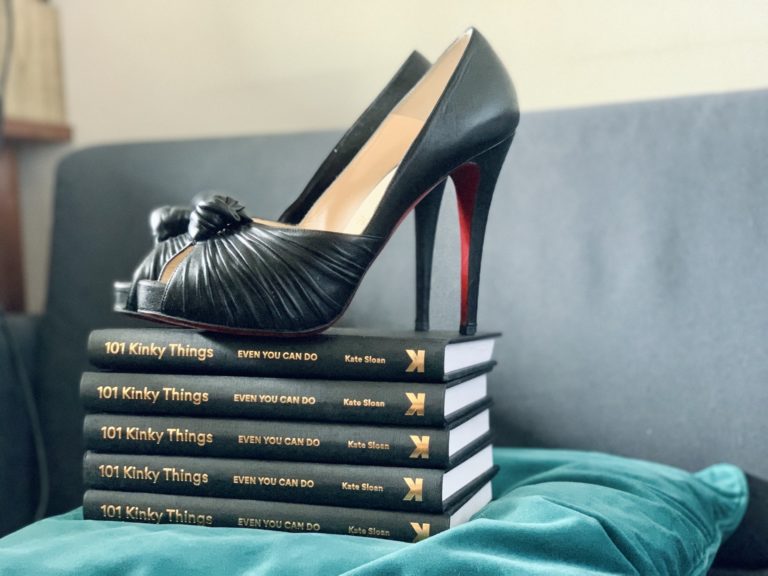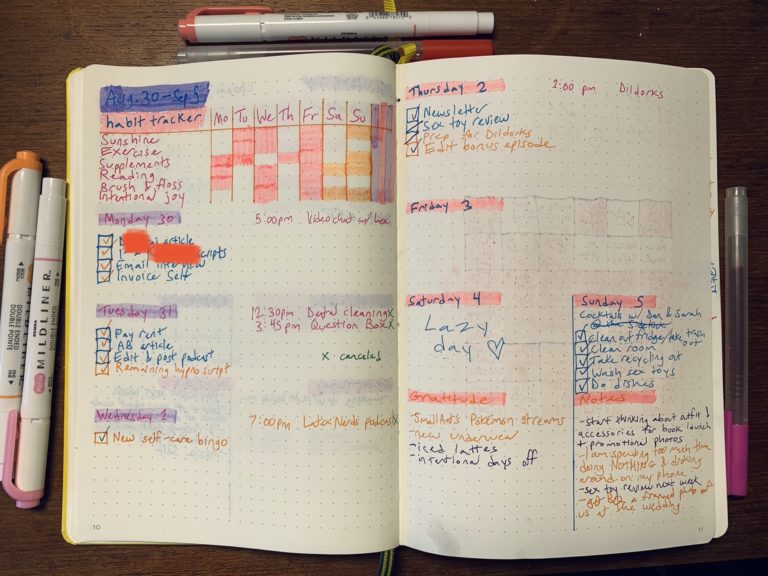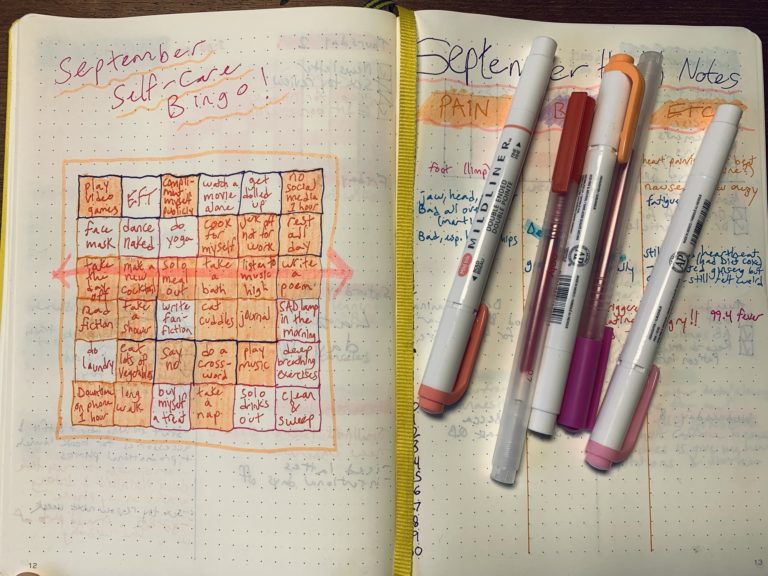
Later this week I have to get on a plane for the first time in a while, and I’m dreading it. Of course, I’m thrilled to be able to go see my spouse, especially since it’ll have been over a month since I last saw them – but the travel itself? Not my fave.
Travel tends to be hell on my chronically ill body, for so many reasons: the stress, the rushing, the cold air, the cramped seats, the waiting around, the social anxiety, the lugging of luggage… Usually by the end of a travel day I am a husk of myself, like I’ve been body-snatched by a sullen alien. Not fun!
However, in all the travel I’ve done as part of this long-distance relationship, I’ve learned how to mitigate my symptoms as best as I can, before, during, and after traveling. Here’s what works for me, incase it helps any of you too…
Routine
Routine is the most important thing for me in my travels. Without a routine, I fall to pieces.
My current travel routine involves making a packing list about a week in advance, packing my suitcase over the course of 1-2 days before I leave (spacing it out as needed due to fatigue and pain), checking into my flight online in advance so I don’t have to do it at the airport, and getting to the airport at least 2.5 hours before my flight takes off. If it’s possible to pre-select a seat, I choose one by the window so I don’t have to get up/move around at all once the flight takes off, and can rest/nap if I need to. (I always have my eye mask with me to block out light incase I need a quick snooze, or am just feeling overwhelmed and need to exist only inside my own head for a while.)
Part of my routine is knowing exactly where I have to go and what I have to do: my terminal, gate, flight number, seat number, etc. I’ll stash my passport and boarding pass in an outer pocket of my carry-on bag so I always know where they are and can access them quickly. Basically my goal is to pre-emptively eliminate as much stress and uncertainty as I possibly can.
Outfit
My go-to travel outfit is as follows:
- A simple modal slip dress, possibly with an Aerie bralette underneath
- Black cotton leggings
- A cardigan over top (cotton in the summer, cashmere in the winter)
- Cozy socks
- Black leather boots
Traveling is such an ordeal that I always want to be as comfortable as possible, all day long. If that means having to wear a literal nightgown onto the plane (albeit dressed up with various other elements to make it look more presentable), so be it! I also hate feeling stressed and rushed in the TSA line, so I engineer my travel outfits to be easy to disassemble and reassemble as needed.
Planes are usually pretty cold, regardless of what the temperature is outside, and cold is one of my big pain triggers, so I never regret having a cardigan with me. If it’s super hot out, I might keep the cardigan in my bag until I get onto the plane, but I always bring one.
Luggage
Luggage cubes are transformative! They are little zippered cases that you can use to organize what you pack. I’ve found them crucial for longer stays, when I don’t want to have to rip my entire suitcase apart to find a fresh pair of underwear or a new shirt. Usually I’ll keep underwear and socks in one, T-shirts in another, and dresses in another. Not only does this make my stuff easier to find; it also helps with compressing my clothes so they take up less space and I can fit more things in my suitcase.
I used to be the type of person who could pack a small carry-on and be fine, but these days I tend to take longer trips and also just don’t have the strength to lug a suitcase around the airport with me anymore, so I always check it instead. It’s pricey – usually $50 for one bag or $80 for two – but I view it as a “disability tax” I just have to pay because my body physically cannot manage as much as an able-bodied person’s can.
Having to wait around at the baggage carousel after my flight is sometimes annoying, especially since at that point I’m usually so mentally and physically exhausted that having to wait a few extra minutes feels like an affront to my sanity, but I just try to calm myself down by playing games on my phone until the bags come out.
Carry-On
My go-to carry-on bag is a black leather Holiday Lane Page tote by Kate Spade. Previously it was a big turquoise leather tote by Coach. My carry-on needs to be comfortable to carry and able to hold all my stuff. It also needs to have a proper zip closure so it doesn’t spill everywhere when I stash it under the airplane seat in front of me. I use the hell out of these bags so I usually have to replace mine every 2-3 years or so (the handles inevitably start to wear through and the bag starts to lose its shape from overuse).
I usually buy some snacks (ideally granola bars or protein bars) at an airport shop once I’ve gone through security and stash them in my bag. Travel sometimes makes me feel a bit faint from all the overexertion and anxiety, and slightly sugary snacks can help. Also always a good idea to grab some gum to chew during takeoff and landing to help with ear-popping. And I always buy some water, because plane air is incredibly drying and dehydration can exacerbate anxiety and pain.
I try to bring distractions that I find joyful and uplifting, since air travel is so… not. Usually I’ll bring my Kindle stocked with good books, my iPad with some games downloaded and some Instapaper articles queued up, my phone and headphones for listening to podcasts or music, and my Nintendo Switch or 3DS for gaming. Sometimes I’ll also journal on the plane, so I gotta have my Moleskine notebook and a pen that won’t explode in the air.
Meds
Air travel is so exhausting, stressful, and demanding for me that I always end up experiencing a lot of body pain during and after travel, so sometimes I’ll pre-empt it by taking a painkiller (naproxen) before leaving for the airport or getting onto the plane. It takes the edge off, at least. I’ll also make sure to take my iron supplement on a travel day because otherwise I run the risk of feeling anaemic and maybe even fainting.
My doctor prescribed me an anxiety medication, Ativan, which I only ever use in emergencies because it’s habit-forming. Usually I keep some in my bag when I travel, because I know from experience that delays, cancellations, last-minute schedule changes, and other stressors can trigger an anxiety attack for me pretty easily, especially since I’ve had so many anxious experiences in airports that my body has a somewhat Pavlovian reaction to them now.
If I’m really freaked out, sometimes I’ll take a weed edible before leaving for the airport, but I wouldn’t recommend this unless 1) you know the route of your journey very well and don’t anticipate it’ll change much AND 2) you have lots of experience with this particular intoxicant and can therefore behave yourself even if you get a little loopy. (It would not be fun to be kicked off a plane for belligerent behavior à la Kristen Wiig in Bridesmaids.)
Arrival
These days I will almost always order an Uber to take me from the airport to wherever I’m staying, if it’s at all financially feasible. The stress of trying to find my way to a subway station or shuttle bus after the ordeal of travel is just too much for my body and brain. I’ve learned from all my experiences that immediately post-flight is a time when I’m highly likely to feel weirdly depressed out of nowhere, due to sheer exhaustion, and that’s a state in which I often feel unable to figure out public transport, especially if I’m worried I might start crying in public (it happens!).
Once I get to my destination, I need to relax. My spouse knows never to plan anything heavy-duty for the night of my arrival. Usually we’ll go out for dinner at a low-key local place. Sometimes I’ll take a hot bath with Epsom salts to de-stress my muscles. Sometimes my spouse gives me a massage, or just holds me close and says things like “You’re safe” and “You did a good job today” and “All the hard stuff is done,” to let my nervous system know that it can finally relax. I get to bed early and usually feel much better in the morning.
Fellow chronically ill people, what helps you when you have to travel?





